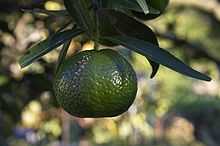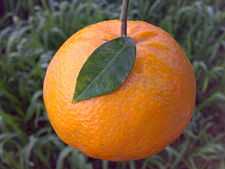Mandarin orange
| Mandarin orange | |
|---|---|
.jpg) | |
| Scientific classification | |
| Kingdom: | Plantae |
| (unranked): | Angiosperms |
| (unranked): | Eudicots |
| (unranked): | Rosids |
| Order: | Sapindales |
| Family: | Rutaceae |
| Genus: | Citrus |
| Species: | C. reticulata |
| Binomial name | |
| Citrus reticulata Blanco | |
The mandarin orange (Citrus reticulata), also known as the mandarin or mandarine, is a small citrus tree with fruit resembling other oranges. Mandarin oranges are usually eaten plain or in fruit salads. Specifically reddish-orange mandarin cultivars can be marketed as tangerines, but this is not a botanical classification.
The tree is more drought-tolerant than the fruit. The mandarin is tender and is damaged easily by cold. It can be grown in tropical and subtropical areas.
According to molecular studies,[1] the mandarin, the citron, the pomelo, and the papeda were the ancestors of all other citrus species and their varieties, through breeding or natural hybridization; mandarins are therefore all the more important as the only sweet fruit among the parental species.
Genetics
See also Citrus taxonomy.
Mandarins are one of the four core ancestral citrus taxa, and are thought to have evolved in Vietnam, southern China, and Japan.[2]
Pure mandarins seem to divide into two groups; an edible group, including the Nanfengmiju, and an "acidic" group, which is too sour to be edible but which is widely used as rootstock and grown for juice; this includes Sunki, Shekwasha, and Cleopatra mandarins.[3]
Under the Tanaka classification system, mikans/satsumas and tangerines are considered to be two species: Citrus unshiu and Citrus tangerina. Under the Swingle system, unshius and tangerines are considered to be groups of mandarin varieties.[3] Unshius and tangerines genetically resemble mandarins,[3] but the genetics are still not throughly studied.
Like all citrus fruit, mandarins hybridize readily with other citrus. Many fruit sold as mandarins are in fact hybrids with some pummelo (C. maxima) ancestry, and are thus on a continumn with clementines, sweet and sour oranges, and grapefruit.[2]
Hybrids between mandarins and other citrus fruits are sold under a variety of names; see below.
Varieties
Cultivars and crosses between the original mandarin and other citrus fruits include:

Pure mandarins
- Nanfengmiju (Citrus reticulata Blanco[4]) A rare non-hybrid citrus.[2] One of the most widely cultivated varieties in China.[5]
- Cleopatra mandarin
- Shekwasha, a very sour mandarin grown for its acidic juice.
- Sunki
- ? Dancy; also known as the zipper-skin tangerine,[6] it may be a pure mandarin.[7]
Unknown
- Satsuma (Citrus unshiu), a seedless variety, of which there are over 200 cultivars, including Wenzhou migana, Owari, and mikan; the source of most canned mandarins, and popular as a fresh fruit due to its ease of consumption
- Owari, a well-known Satsuma cultivar that ripens during the late fall season
- Tangerine (Citrus tangerina)[8]
- Yuukou mandarin - a yellow Japanese citrus found in the wild
Hybrids with mandarin ancestry

- Clementine, (Citrus ×clementina), a hybrid between a mandarin orange and a sweet orange,[9] so named in 1902;[10] sometimes known as a "Thanksgiving Orange" or "Christmas orange", as its peak season is winter; becoming the most important commercial mandarin orange form, having displaced mikans in many markets
- Huanglingmiao, a mandarin × pumelo hybrid[12][13]
- Kinnow (see image).
- The Ponkan, a mandarin × pumelo hybrid[2][9]
- Meyer lemon, a mandarin × lemon hybrid.
- Rangpur, a different mandarin × lemon hybrid.
- Tangor, also called the temple orange, a cross between the mandarin orange and the common sweet orange;[12] its thick rind is easy to peel and its bright orange pulp is sour-sweet and full-flavored
- Mediterranean/Willowleaf/Thorny (Citrus ×deliciosa), a mandarin × pumelo hybrid[9]
Non-mandarins
- Mangshanyegans, long thought to be mandarins, are in fact a separate species.[12]
Canning

Canned mandarin segments are peeled to remove the white pith prior to canning; otherwise, they turn bitter. Segments are peeled using a chemical process. First, the segments are scalded in hot water to loosen the skin; then they are bathed in a lye solution, which digests the albedo and membranes. Finally, the segments undergo several rinses in plain water.
Biological characteristics
Citrus fruits are usually self-fertile (needing only a bee to move pollen within the same flower) or parthenocarpic (not needing pollination and therefore seedless, such as the satsuma).
Blossoms from the Dancy cultivar are one exception. They are self-sterile, and therefore must have a pollinator variety to supply pollen, and a high bee population to make a good crop. The fruit is oblate.
Raw mandarine has 53 calories from 13g of carbs,0.31g of fat and 1g of protein.[16]
Medicinal uses

In traditional Chinese medicine, the dried peel of the fruit is used in the regulation of ch'i, and also used to treat abdominal distension, to enhance digestion, and to reduce phlegm.[17] Mandarins have also been used in ayurveda (traditional medicine of India).[18]
Production volume
| Tangerines, mandarins, clementines, satsumas Top 20 producers in 2011 (1000 tonnes) | |
|---|---|
| | 12,482 |
| | 2,117 |
| | 1,005 |
| | 928 |
| | 872 |
| | 853 |
| | 848 |
| | 800 |
| | 753 |
| | 681 |
| | 596 |
| | 515 |
| | 406 |
| | 401 |
| | 360 |
| | 236 |
| | 218 |
| | 197 |
| | 179 |
| | 152 |
| All other | 1,582 |
| World total | 26,030 |
| Source: UN Food & Agriculture Organisation (FAO),[19] | |
The "Clemenules" (or "Nules" accounts for the great majority of clementines produced in the world. Spain alone has over 200,000 acres (800 km2), producing fruit between November and January. Mandarins marketed as tangerines are usually Dancy, Sunburst or Murcott (Honey) cultivars.
Cultural significance
During Chinese New Year, mandarin oranges and tangerines are considered traditional symbols of abundance and good fortune. During the two-week celebration, they are frequently displayed as decoration and presented as gifts to friends, relatives, and business associates.
Mandarin oranges, particularly Satsumas from Japan, are a Christmas tradition in Canada, as well as the United States and Russia. They are commonly purchased in 5- or 10-pound boxes, individually wrapped in soft green paper, and given in Christmas stockings. This custom goes back to the 1880s, when Japanese immigrants in the United States began receiving Japanese mandarin oranges from their families back home as gifts for the New Year. The tradition quickly spread among the non-Japanese population, and eastwards across the country: each November harvest, "The oranges were quickly unloaded and then shipped east by rail. 'Orange Trains' – trains with boxcars painted orange – alerted everyone along the way that the irresistible oranges from Japan were back again for the holidays. For many, the arrival of Japanese mandarin oranges signaled the real beginning of the holiday season."[20]

This Japanese tradition merged with European traditions related to the Christmas stocking. Saint Nicholas is said to have put gold coins into the stockings of three poor girls so that they would be able to afford to get married.[21] Sometimes the story is told with gold balls instead of bags of gold, and oranges became a symbolic stand-in for these gold balls, and are put in Christmas stockings in Canada[21][22] along with chocolate coins wrapped in gold foil.
In the United States, importation of these Japanese oranges was suspended due to hostilities with Japan during World War II.[20] While they were one of the first Japanese goods allowed for export after the end of the war, residual hostility led to the rebranding of these oranges as "mandarin" oranges.[20]
The delivery of the first batch of mandarin oranges from Japan in the port of Vancouver, British Columbia, is greeted with a festival that combines Santa Claus and Japanese dancers[22]—young girls dressed in traditional kimonos.[23]
See also
- Fairchild tangerine
- Ju Song - In Praise of the Orange-Tree
- Mandelo
- Tangelo
References
- ↑ "International Citrus Genomics Consortium". University of California.
- ↑ 2.0 2.1 2.2 2.3 http://www.biomedcentral.com/1471-2156/15/152
- ↑ 3.0 3.1 3.2 http://dx.doi.org/10.1007/s11295-010-0314-x
- ↑ http://www.sciencedirect.com/science/article/pii/S0273230011002534
- ↑ http://articles.latimes.com/2010/jan/13/food/la-fow-marketwatch8-2010jan13
- ↑ http://edis.ifas.ufl.edu/ch074
- ↑ http://www.dx.doi.org/10.1007/s00122-006-0255-9
- ↑ "Synonymy of C. tangerina at The Plant List".
- ↑ 9.0 9.1 9.2 9.3 http://www.dx.doi.org/10.1038/nbt.2954
- ↑ Edible: An Illustrated Guide to the World's Food Plants. National Geographic. 2008. p. 73. ISBN 978-1-4262-0372-5.
- ↑ Toni Siebert (30 July 2009). "Nules". Citrus Variety Database. University Of California. Retrieved 9 June 2011.
- ↑ 12.0 12.1 12.2 http://www.dx.doi.org/10.1038/nbt.2906
- ↑ http://www.dx.doi.org/10.1007%2Fs00122-006-0255-9
- ↑ http://edis.ifas.ufl.edu/ch078
- ↑ http://plantbiology.ucr.edu/faculty/Tango%20Information%20Sheet-4-12-2009.pdf
- ↑ Full Nutrition Facts and Calories in Tangerines (mandarin Oranges) | RecipeOfHealth.com
- ↑ Yeung. Him-Che. Handbook of Chinese Herbs and Formulas. 1985. Los Angeles: Institute of Chinese Medicine.
- ↑ Chopra, R. N.; Nayar, S. L.; Chopra, I. C. Glossary of Indian Medicinal Plants. 1986. New Delhi: Council of Scientific and Industrial Research.
- ↑ "Faostat". Faostat.fao.org. Retrieved 2013-12-19.
- ↑ 20.0 20.1 20.2 ORANGES 6.pdf "Information on This Week's Product: Mandarin Oranges" (PDF). BC Agriculture in the Classroom Foundation. Retrieved 24 January 2013.
- ↑ 21.0 21.1 "Personalized Christmas Stockings". centrinet.com.
- ↑ 22.0 22.1 Marion, Paul (December 19, 2010). "Oranges at Christmas". richardhowe.com: Lowell Politics and Lowell History. Retrieved 15 January 2013.
- ↑ "Christmas Stockings". Christmas Traditions in France and in Canada. Ministère de la culture et de la communication de France. Retrieved 15 January 2013.
- Notes
- Citrus reticulata at Plants for a Future
External links
 Media related to Citrus reticulata at Wikimedia Commons
Media related to Citrus reticulata at Wikimedia Commons Data related to Citrus reticulata at Wikispecies
Data related to Citrus reticulata at Wikispecies- Mandarin Orange Nutrition Facts
- UC Riverside Mandarin Variety Descriptions
- Mandarin Orange - from Morton, J. (1987) Fruits of Warm Climates
